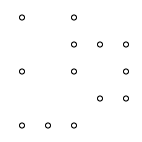In the badge pathways paraquel post we discussed the importance of the whole system and how your badges can coalesce into something greater than its parts. But let’s talk about what the parts of the system are. The parts of the system can include badges, goals, earners, organizations, stakeholders, and time. Why is it important to discuss these when we’re talking about badge pathways? Because your badge pathways will come about through pushes and pulls in the system; through different desires and needs manifesting themselves through the medium of badges.
Chains of importance, cowpaths & desire paths
In a recent conversation on the Webmaker google group, Christian Briggs shared some of his thinking about badge pathways. He mentioned a process of discovery he and a team had worked out that addressed chains of importance for all folks. This aligns with much of our earlier thinking and writing here.
At a meeting about the future of badges earlier this year, I floated the idea of badge pathways as essentially cowpaths. I mentioned this in reference to the idea of “paving the cowpaths”; seeing where the traffic goes and then paving where the paths are worn. As you can imagine, if you’re not familiar with this phrase and its related concept, it can take some getting used to. Rafi Santo kindly jumped in to offer the much more preferable desire paths. But regardless of the language used, what’s valuable and important here is where someone wants to go versus where they’re told to go.
Descriptive pathways vs. prescriptive pathways
Let’s take a minute to understand the difference between descriptive approaches and prescriptive approaches. Descriptive pathways approaches seek to acknowledge the ways that people willfully choose to earn badges. This technique may feel more natural to the badge earner since they’re defining their own paths. In this manner, the badge earner makes use of personal agency. Prescriptive approaches seek to declare one standard or recommended badge earning path over another. It can feel more limiting and formal. The badge earner is compelled to follow the proposed pathway or drop out of the pathway. Each approach has its own pluses and minuses.
The three-fold path
Several potential uses of these two approaches exist. For example, people may choose to (or be compelled to) move through a badge system in these three ways:
- Command path: suggested or recommended badge arcs.
- Contract path: desired or pledged badge groupings.
- Badge desire path: independently followed or pursued badge passages.
The importance of the distinctions between these paths cannot be overemphasized. Why? Because to the earner, each of these avenues will feel very different.
Part of the beauty of open badges in general is their extreme flexibility. This flexibility extends all the way from their creation to their earning, from their earning to their consumption. The system is designed to accommodate flexibility and alternative uses. This means that all badge creators/issuers are developing badge systems that will express emergence—one way or another. And one of the ways that emergence will come about is in the ways that people will choose to progress through your badges. So let’s return to the three different pathways.
Command pathways
The command approach is the most prescriptive: it relies on a formal, structured and recommended path. Most likely, this badge pathway will be linear—a straight line from one learning experience to another. This is not unlike what occurs in many school courses.
Contract pathways
The contract path encourages the earner to think about and select a potential learning arc. In the strictest sense, it, too, is prescriptive. But because its prescriptiveness is set forth by the earner herself, the potentially dictatorial nature does not carry the same paternalistic qualities.
Desire pathways
The badge desire path carries with it the greatest capacity for knowledge and system emergence. When there is no prescribed pathway, people can find the way that makes sense to them; can choose to follow other people’s paths or can strike out in very different directions.
The learning trail
All badge earners leave behind a trail. That badge trail may prove to represent merely a series of required steps; that path may illustrate a series of revealing, personally inspired choices, or that path may appear to be erratic and nonsensical, indicating nothing. But rarely is that last example the case. All of these directions may make perfect sense to the badge earner. But perhaps the one that makes the most sense to her is her own constructed narrative: the path that she develops a story about, even if her story can only be understood in retrospect. Sense-making often occurs after an experience: that doesn’t render the process any less meaningful, even if that process has seemed peculiarly arbitrary and idiosyncratic. They’re sending you messages about finding meaning and building personal value in the midst of communication chaos. And do not underestimate the immense power of self-reflection and self-assessment. Indeed, the badge earning iconoclast asks the badge system—and the people designing it—to not only acknowledge their atypical badge pathway approaches but also to appreciate their unique ability to see what might be rather than what is. They’re your badge system’s true north.
– – –
More soon.
carla [at] mozillafoundation [dot] org




I almost want to break the Desire pathway down further:
Intentional pathway
Similar to the Contract pathway in that the learner is projecting a way forward, but less stringent in that rerouting can occur at any point depending on changing internal and/or external conditions. An Intentional pathway is one a learner may be tentatively aiming toward, but not entirely committed to. This is a projected pathway that is likely to change as learning occurs. It may be valuable to document how projected paths change over time (perhaps attached as metadata at each point/badge along the learning trail) as a means for evaluating personal expectations and assessing growth.
Wandering pathway
Little to no pathway projection done up front. This pathway is truly explorational in nature!
I agree with what you’re saying, but I feel that while you’ve spelled out the clear advantages to the fully learner-driven “desire” pathways, the unique merits of the others also deserve further exploration, particularly the middle-tier “contract pathways”.
A learner by definition does not have a full understanding of the material, and by extension, does not have a full awareness of the potential learning space. I may have liked computers in high school, but that doesn’t mean I understood the full breadth of options available for study within that space — I didn’t know what I didn’t know. To that end, I believe there is a place for prescriptive pathways in the learning space, as a map or survey of the domain.
There are many balances to be struck between the desire of the learner and his or her capacity for self-guidance. A “contract” pathway could hypothetically facilitate exploration of an unknown space by mapping it and setting some initial parameters. It could also create common points of reference for the various stakeholders in the ecosystem — for students to orient themselves, for teachers and mentors to train to support, and for consumers to understand and accept. These qualities suggest that “contract” pathways could operate best alongside “desire” pathways, which have a far greater capacity for descriptive mapping.
Learning has need for both exploration and guidance — they are complementary, not adversarial. Ultimately, I believe a functioning Open Badge ecosystem will and must include all types of pathways, because each has innate advantages, for different learners and at different times, and they will work best together.
This is a fantastic post! Totally agree with all this. I believe a lot of my Heutagogical / Self-directed learner focus in using badges falls within the Desire pathways. Good to be getting a common vocabulary around all this. I do wonder if their is something between a Contract and Desire pathway, what happens with someone who is following a mentor and pursuing a set of badges based on someone who has been on a desire pathway for years?
Pingback: Badge pathways: part 2, the "quel" | ...
Pingback: Teach the Web | Webmaking as Learning